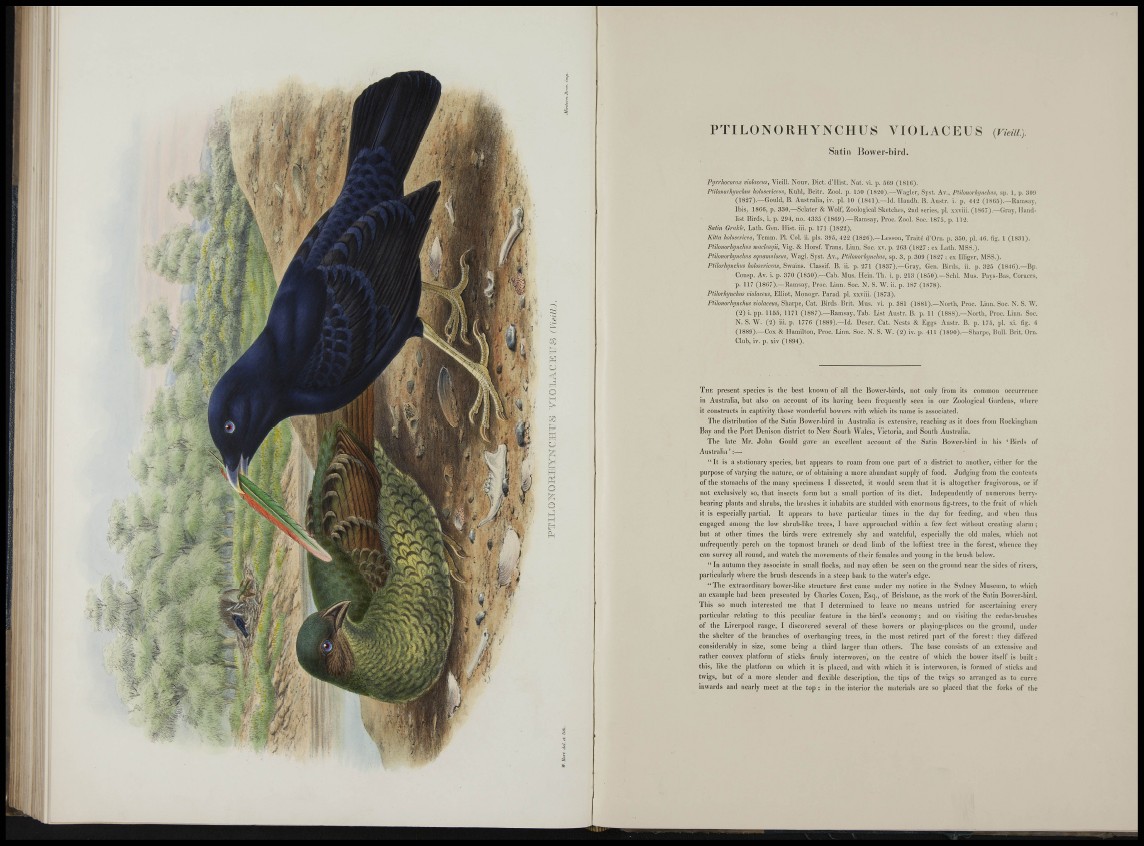
; I ¡,
•li J
I
5S
p
a
b'
o
S
p
a
oe
y
Q
S
H
i n
P T I L O N O R H Y N C H U S V I O L A C E U S {Fíeüi.,
Satin Jiovver-l)inI.
Pp-rhocorax viohceusy Vieill. Nouv. Diet, d'ilist. Nat. vi. p. 5(ii) (181ii).
Ptilonorhjmhis liolosericciis, Kuhl, Beitr. Zool. ji. 150 (18-20).—Waglcr, Syst. Av., Ptilonorhi/iichiis, sp. 1, p. ,'1011
(1827).—Gould, B. Australia, iv. pl. 10 (1841).—kl. llaudb. H. Austr. i. p. 44-2 (180.5).—Kamsay,
Ibis, 1866, p. 330.—Sclater & Wolf, Zoological Sketclies, 2nd series, pl. xxviii. (1867).—Gray, Ilandlist
Birds, i. p. 294, no. 4335 (1869).—Rarasay, Proe. Zool. Soc. 1875, p. 112.
Satin Gralde, Lath. Gen. Hist. Iii. p. 171 (1822).
Kitta holosericea, Temni. PI. Col. il. pis. 395, 422 (1826).—Lesson, Traité d'Orn. p. 350, pl. 46. fig. 1 (1831).
PtUonorhjnchm maclmyii, Vig. & Horsf. Trans. Linn. Soc. xv. p. 263 (1827 : ex Latli. MSS.).
PHhnurh/nchus squamiilosiis, Wagl. Syst. Av., Pithiwrhjuchts, sp. 3, p. 30!) (1827 : ex Illiger, MSS.).
Ptilorhynchii hobsericeus, Swains. Classif. B. il. p. 271 (1837).—Gray, Gen. Birds, ii. p. 325 (184C).—Bp.
Consp. Av. i. p. 370 (1850).—Cab. Mus. Hein. Th. i. p. 213 (1850).—Sehl. Mus. Pays-Bas, Coraees,
p. 117 ( 1 8 6 7 ) . -Rams a y , Proc. Linn. Soc. N. S. W. ii. p. 187 (1878).
Ptilorhjnchm violacaus, Elliot, Mouogr. Parad. pl. xxviii. (1873).
Ptilonorlnjiichm violaceas, Sharpe, Cat Birds , B r i t . Mus. vi. p. 381 (1881).—North, Proc. Linn. Soc. N. S. W.
( 2 ) i. pp. 1155, 1171 (1887).—Ramsay, Tab. List Austr. B. p. 11 (1888).—North, Proe. Linn. Soc.
N. S. W . (2) iii. p. 1776 (1889).—Id. Deser. Cat. Nests & Eggs Austr. B. p. 175, pl. xi. fig. 0
(1889).—Cox & Hamilton, Proc. Linn. Soe. N. S. W . (2) iv. p. 411 (1890).—Sharpe, Bull. Brit. Orn.
Club, iv. p. xiv (1894).
THE present s])ecies is tlie best known of all the Bower-i)ir(ls, not ot)ly from its common occurrence
in Australia, but also on account of its having been frequently seen in our Zoological Gardens, where
it constructs in captivity those wonderful l)owers with which its name is associated.
T h e distribution of ihe Satin Bower-bird in Australia is extensive, reaching as it does from liockinghani
Bay and the Port Denison district to New South Wales, Victoria, arid South Australia.
T h e late Mr. John Gould gave an excellent account of the Satin Bower-bird in his 'Birds of
A u s t r a l i a ' : —
" I t is a stationary species, but appears to roam from one j)art of a district to another, eitiier for the
])urpose of varying tlie nature, or of obtaining a more abundant supply of food. Judging from tlie contents
of the stomachs of tlie many specimens I dissected, it would seem that it is altogether frugivorous, or if
not e.xclusively so, that insects form but a small portion of its diet. Independently of numerous berryb
e a r i n g plants and shrubs, the brushes it inhabits are studded with enormous fig-trees, to the fruit of which
it is especially partial. It appears to have partienlar times in the day for feeding, and when thus
engaged among the low shrub-like trees, I have approached within a few feet without creating alarm ;
but at other times the birds were extremely shy and watchful, especially the old males, which not
unfrequently jierch on the topmost branch or dead limb of the loftiest tree in the forest, whence they
can survey all rouiul, and watch the movements of their females and young in the brush below.
" I n autumn they associate in small flocks, and ntay often be seen on the ground near the sides of rivers,
p a r t i c u l a r l y where the brush descends in a steep bank to the water's edge.
" T h e extraordinary bower-like structure first came under my notice in the Sydney Museum, to which
an example had been presented by Charies Co.xen, Esq., of Brisbane, as the work of the Satin Bower-bird,
l^liis so much interested me that I determined to leave no means untried for ascertaining every
p a r t i c u l a r relating to this peculiar feature in the bird's economy; and on visiting the cedar-brushes
of the Liverpool range, I discovered several of these bowers or playing-plaees on the ground, under
t h e shelter of the branches of overhanging trees, in the most retired part of the forest: they differed
considerably in size, some being a third larger than others. The base consists of an extensive and
r a t h e r convex platform of sticks firmly interwoven, on the centre of which the bower itself is built:
this, like the platform on vvliieh it is placed, and with which it is interwoven, is formed of sticks and
twigs, but of a more slender and flexible descri])tion, the tips of the twigs so arranged as to curve
inwards and neariy meet at the top : in the interior the materials are so placed that the forks of the